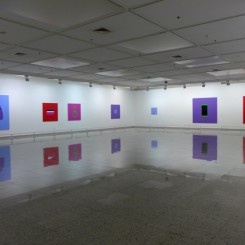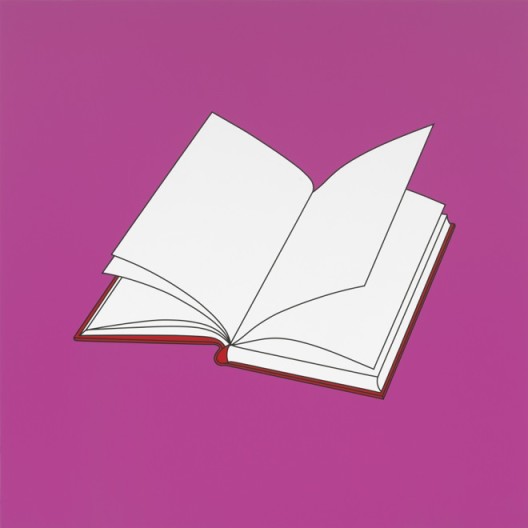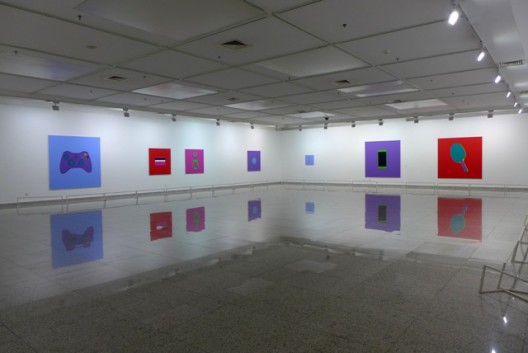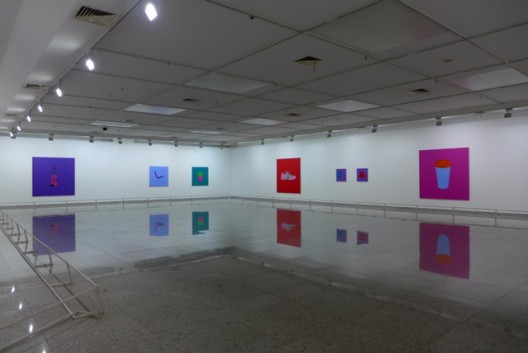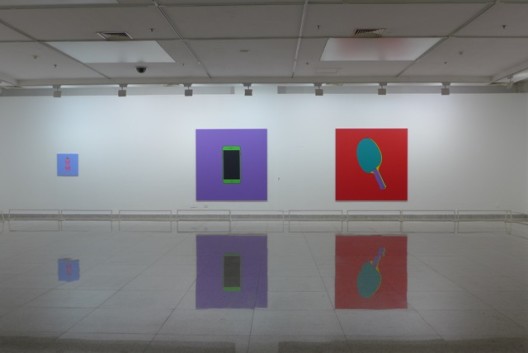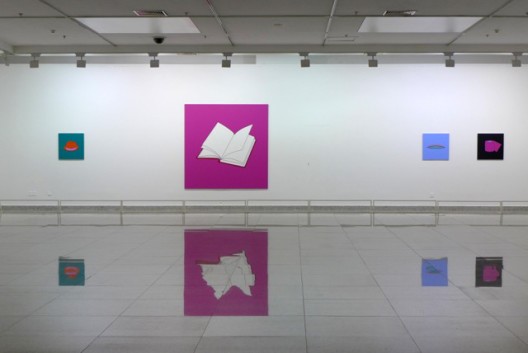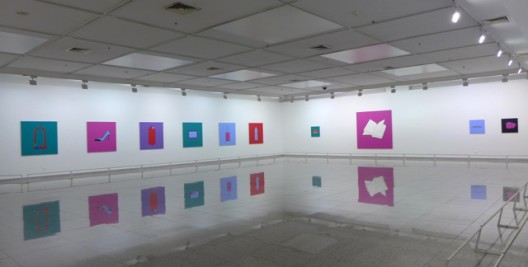by Julie Chun
NOW: Michael Craig-Martin, 2015 China Tour Exhibition
Shanghai Himalayas Museum (3/F, No. 869 Yinghua Road, Shanghai), Feb 3–Apr 12, 2015
Hubei Museum of Art (1 Sanguandian, Donghu Lu, Wuhan, Hubei), Apr 23–Jun 21, 2015
Walking into the hallowed inner rooms of the Shanghai Himalayas Museum, the viewer is greeted by forty-two eye-jarring canvases of contemporary objects, a few which appear outdated even though they were recently painted by Michael Craig-Martin for his touring exhibition “NOW”. This odd discrepancy, as shall be revealed, seems to be a part of the artist’s intent, for it is the very banal substance of the everyday that often shifts the seemingly simple categorization of utility and desire in our fetishized society.
Some context can provide further clues. Michael Craig-Martin was born in Dublin in 1941, but moved to Washington DC in United States in 1945 due to his father’s job. Despite returning to Europe in 1966 and been residing and working in London for almost fifty years, he still speaks with a distinctive American accent. He is an artist who, since earlier times, straddled two continents, two artistic cultures, and two national histories to embody the status of a global artist, even before the term was in wide circulation. Moreover, his great-grandmother was Chinese, from Wuhan. Thereby, Craig-Martin’s mixed ethnicity also marks his transnational, cross-cultural identity before this distinction became a more prevalent phenomenon. Despite his white hair, which he wears neatly cropped, there is an inherent cool-factor about him that seems anachronistic or at odds with his age.
His professional history also links him to British artists of the present. Craig-Martin was part of the faculty who instructed and fostered many students who graduated from Goldsmiths College in 1987-1990 to achieve the ultra-prominent YBA status (Young British Artists). The leader of the group, Damien Hirst, has commented on the unforgettable quality of Craig-Martin’s 1974 installation consisting of a glass half filled with water on a glass shelf with an accompanying Q&A text that asserts the display as “An Oak Tree.” “That piece is, I think, the greatest piece of conceptual sculpture,” Hirst stated in The Telegraph. “I still can’t get it out of my head.”1
Interestingly, rather than pursuing conceptual art which brought the art world’s attention on him with “An Oak Tree,” Craig-Martin turned his artistic practice, in 1978, towards drawing recognizable everyday objects. This shift has not been fully elaborated in any texts or interviews—not even by the artist himself, who congenially deflects questions he doesn’t care to answer with understated humor and a gracious smile. In his early Line Drawing series, Craig-Martin became absorbed in using the commonplace as his subject matter. Rendering the images with absolutely no shading or color, the tracings made with black tape evoke the stark diagram-aesthetics found in technical user manuals. The artist conflates several objects in a single image, and the result is such that the overlapping quality produces an ironic, disorienting sense of depth.
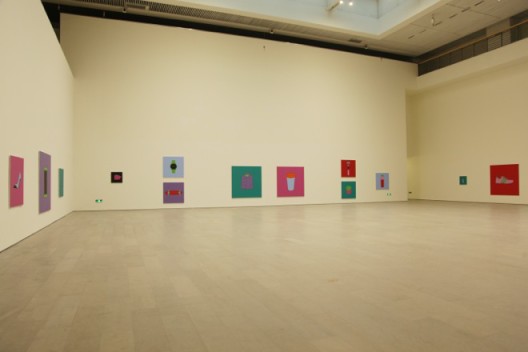
Exhibition view, Shanghai Himalayas Museum (courtesy Shanghai Himalayas Museum)
现场图,上海喜马拉雅美术馆(上海喜马拉雅美术馆惠允)
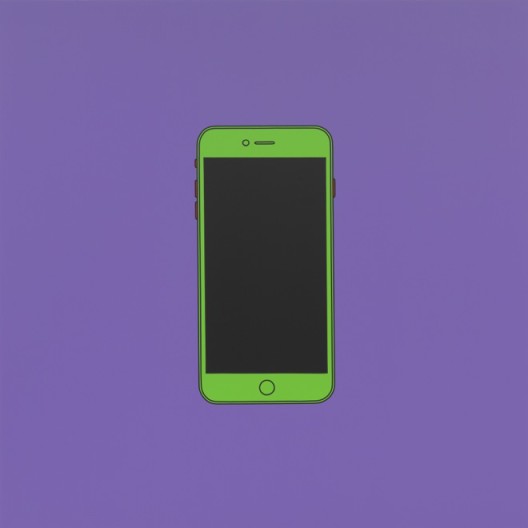
Michael Craig-Martin, “Untitled (iPhone)”, acrylic on aluminium, 200 x 200 cm (unframed), 2014 (© Michael Craig-Martin)
迈克尔·克雷格-马丁,《无题(iPhone)》,铝板丙烯,200 x 200 cm(无框),2014(©Michael Craig-Martin)
According to Craig-Martin, “The irony is that line drawing is in fact less like the objects drawn than any other method of drawings. There are planes, shadows, colors in the things we observe, but no lines. There are no lines in nature, in the human body, in fabricated objects. The lines in drawing are an invention. Line drawing is the most complete artifice in art.”2
From about the early 1980s, Michael Craig-Martin began to inject vibrantly juxtaposed colors into his canvases, but aside from this transformation, the oeuvre of his painting has changed very little, and remains relatively consistent to this very day in purposefully employing the vocabulary of ordinary objects, whether onto the space of the canvas or painted directly onto walls as murals. He retains templates of his own drawings, some of which he re-uses, thus bestowing upon his canvases a quality of machine-like illustration. This aspect of privileging quintessentially mass-produced goods, in combination with his use of a clear, bright palette, has invited an unwanted comparison with works of Pop Art.
Yet, Craig-Martin’s images of ubiquitous objects are far removed from Pop’s iconic vestiges of popular and consumer culture that arose in response to American economic affluence in the decades following World War II. “Andy Warhol, like all Pop artists, was interested in making art out of pre-existing images: adverts, news and celebrity photos, labeling, comics, signage, etc. I have no interest in these things. I am interested in how we perceive and understand the world through objects and their images,” states Craig-Martin.
To philosophers like Aristotle and later St. Augustine, words or pictures represented abstract propositional content through which an unknown truth is revealed. According to St. Augustine, a sign is “something that shows itself to the senses and something other than itself to the mind.”3 In this manner, “An Oak Tree” exemplified the possibilities of deducing an alternate epistemological interpretation stemming from this sight-mind tension. Elizabeth Manchester of Tate Modern writes: “‘An Oak Tree’ is based on the transubstantiation in which bread and wine formed the body and blood of Christ while retaining their appearances of bread and wine.”4 Manchester continues, “The ability to believe that an object is something other than [what] its physical appearance indicates requires a transformative vision.”5
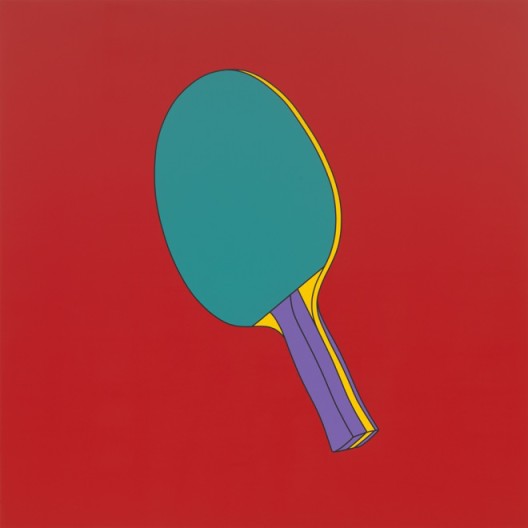
Michael Craig-Martin, “Untitled (table tennis paddle)”, acrylic on aluminium, 200 x 200 cm (unframed), 2014 (© Michael Craig-Martin)
迈克尔·克雷格-马丁,《无题(乒乓球拍)》,铝板丙烯,200 x 200 cm(无框),2014(©Michael Craig-Martin)
This transformative vision needs to be achieved by the artist for it to affect the spectator. Consequently, the turn taken by Craig-Martin from his abstract conceptual work in “An Oak Tree” to the literal representation of commonplace items wasn’t completely literal after all. The recognizable objects that he paints do not necessarily tell us what they are; rather, they are symbolic of what the object can imply. There is a perverse play of juxtaposing forces at work here, because it seems rather obvious that we know what these objects are.
“When I started drawing ordinary objects, I thought they were pretty stable in the world. I assumed that they would not change over time. Things should look like what they do and one should be able to understand the function of an object by its appearance,” says Martin, “Today, this is much less true. The new objects, for example the iPhone, the iPad, the laptop, all look strikingly alike regardless of their different functions. And none of them look like what they do.”
Undeniably, not only will these recognizable mass-produced devices fall out of favor in another season with the next enumerated version, but more critically, they allude to the inevitable accelerated life cycle of manufactured objects and its corresponding thirst for personal technological acquisitions. Where Craig-Martin succeeds with “NOW” in China is bringing our attention to the multiple signifiers associated with the “cultural biography” of objects to underscore the ever-shifting cycle of the accouterments that have come to define—and even dictate—our contemporary lives. The central questions posed by anthropologist Igor Kopytoff in his essay “The Cultural Biography of Things,” can be invoked here for many of us who never even gave a thought to: “Where does the thing come from and who made it? What has been its career so far, and what do people consider to be an ideal career for such things? What are the recognized ‘ages’ or the periods in the thing’s ‘life,’ and what are the cultural markers for them? How does the thing’s use change with its age and what happens to it when it reaches the end of its usefulness?”6
One after another, the array of canvases by Craig-Martin seems to ask these questions on our behalf. Displaying the machine-aesthetic of diagrams but meticulously hand-painted by the artist with the help of only one assistant, the simple, isolated objects are loaded with juxtapositions. Though rendered in a seemingly static depiction, each image conjures associations of desire, contempt, nostalgia and even indifference, thus signifying the dynamic process of subjectivity this banal signage can foment in each one of us, displacing language and cultural barriers.
In the general scheme of this tightly-forged and well presented exhibition, there nonetheless persists an unrelenting disquietude in which the tensions of form and content do not easily negotiate. Craig-Martin made clear, “I have no interest in fetishism, product design, or consumerism. I am interested in objects, what they look like, what they are for, what they tell us about ourselves, but I don’t make objects, I draw and paint them. I am interested in the relation of objects to images and in the language of images.”
It is true that he does not fabricate the items he depicts, but is the maker of these images. Yet, where the unsettling slippage occurs is in the very fact that these canvases are explicit commodities with monetary exchange value. Each painting in the exhibition has its own undeniable “saleability” of (exceptionally high) commercial value, evinced by the touring exhibition’s close collaboration with the international enterprise of Gagosian Gallery who provided support and part of the funding. Likely, in this instance, the “closed” site of the museum as a place of cultural hegemony, rather than the “open” space of the commercial gallery, serves possibly as a neutral and uncontested arena for these artistic commodities to be considered in other ways. In this context, Craig-Martin’s images of objects are transformed to take on a different “singularizing” or “sacralizing” value as artistic or creative objects (here, I borrow terms from Kopytoff). As Kopytoff affirms, it is culture (and precisely art) that can ensure this status of singularity, which can also be tinged with elitism. There is much more offered here than a mere portrait of a plastic water bottle and an electric toothbrush. In considering the context here, we are reminded of the potential of art in its ability to transpose what we see before us into a plurality of complex meanings: the very sign of our times.
Endnotes
1. Cressida Connolly, “Michael Craig-Martin: out of the ordinary”, Nov 24 2007 (http://www.telegraph.co.uk/culture/3669527/Michael-Craig-Martin-out-of-the-ordinary.html; link)
2. Michael Craig-Martin, “On line drawing” in NOW: Michael Craig-Martin 2015 China Tour Exhibition (Shanghai: Shanghai Himalayas Museum, 2015), 17.
3. St. Augustine, De dialectica, ed. Jan Pinborg, translation with intro. and notes by B. Darrel Jackson (Dordrecht: Reidel, 1975), 86.
4. Elizabeth Manchester, “An Oak Tree 1973: Summary”, Tate, 2002 (http://www.tate.org.uk/art/artworks/an-oak-tree-l02262/text-summary; link)
5. Ibid.
6. Igor Kopytoff, “The cultural biography of things: commoditization as process,” in The Social Life of Things: the Commodities in Cultural Perspective, ed. Arjun Appardurai (Cambridge: Cambridge University Press, 1986), 66-67.
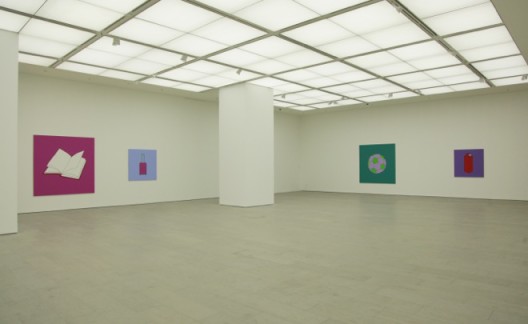
Exhibition view, Shanghai Himalayas Museum (courtesy Shanghai Himalayas Museum)
现场图,上海喜马拉雅美术馆(上海喜马拉雅美术馆惠允)
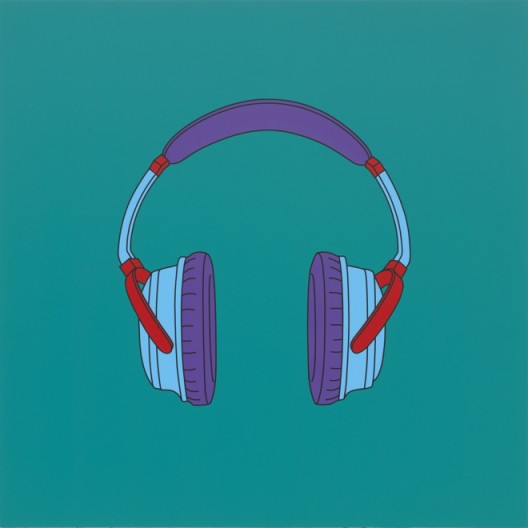
Michael Craig-Martin, “Untitled (headphones medium)”, acrylic on aluminium, 122 x 122 cm (unframed), 2014 (©Michael Craig-Martin)
迈克尔·克雷格-马丁,《无题(中号耳机)》,铝板丙烯,122 x 122 cm (无框),2014(©Michael Craig-Martin)

